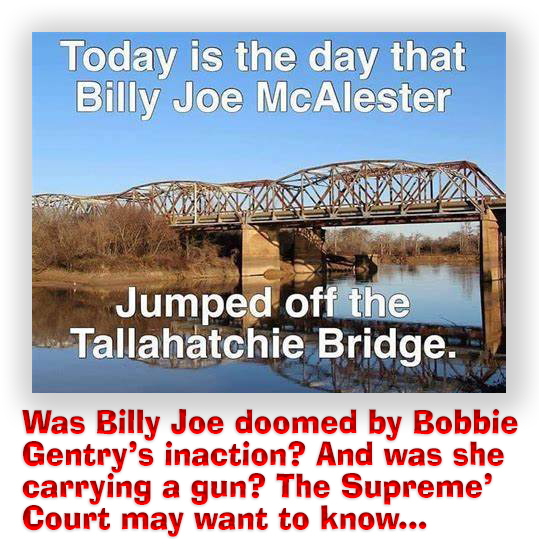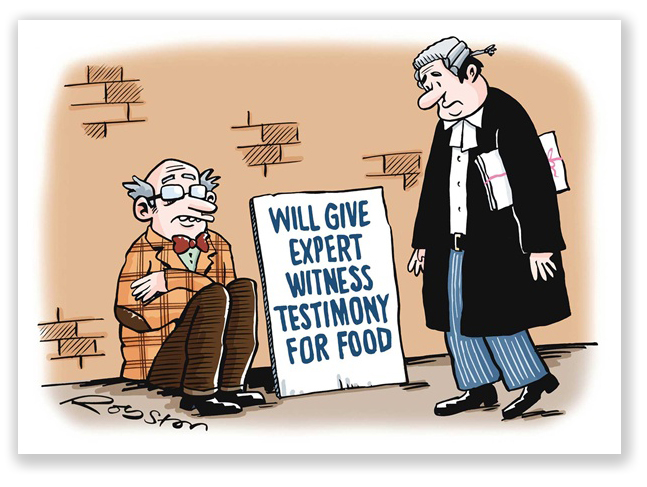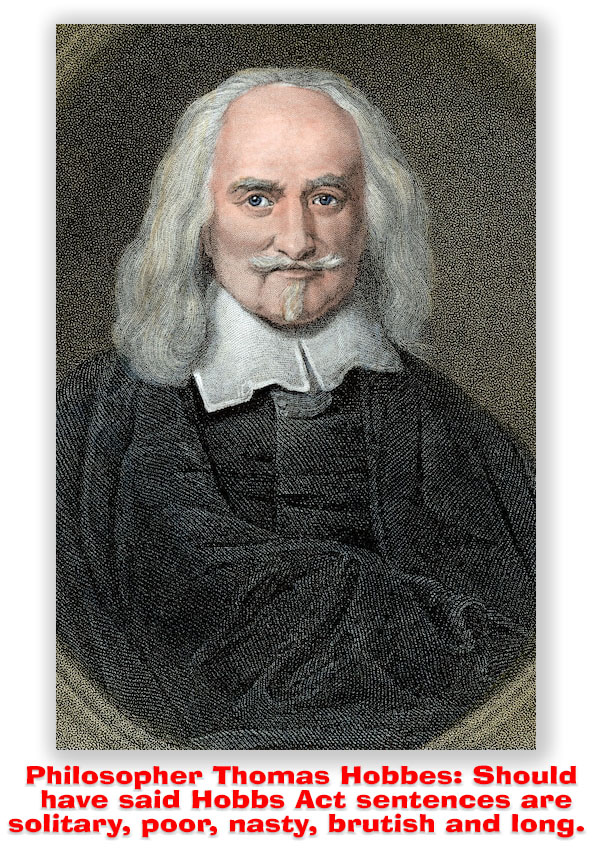We post news and comment on federal criminal justice issues, focused primarily on trial and post-conviction matters, legislative initiatives, and sentencing issues.

SCOTUS WILL DECIDE WHETHER DOING NOTHING IS VIOLENT
 Today is June 3rd, forever to be remembered as the day Billy Joe McAllister jumped off the Tallahatchie Bridge (if you recall that 1967 earworm by Bobbie Gentry or the forgettable movie that followed it).
Today is June 3rd, forever to be remembered as the day Billy Joe McAllister jumped off the Tallahatchie Bridge (if you recall that 1967 earworm by Bobbie Gentry or the forgettable movie that followed it).
But what really happened that fateful day? If Bobbie pushed him, she committed a crime of violence. But what if he slipped, called for her to throw him a rope, and she sat there doing nothing? Would that also be a crime of violence? And why would we care?
We may never know about the star-crossed lovers or Billy’s inner demons, but the Supreme Court decided today that it will decide whether nothing is the same as something in the world of violent crime.
The “categorical approach” to whether an underlying offense is a crime of violence has both complicated 18 USC § 924(c) cases and benefitted a number of people wrongly convicted of possessing a gun during a crime of violence or punished under the Armed Career Criminal Act (18 USC § 924(e)(2)).
 Section 924(c)(3) provides that a crime of violence encompasses any felony that “has as an element the use, attempted use, or threatened use of physical force against the person or property of another.” The “categorical approach” to determine whether a predicate offense is a crime of violence focuses on the elements of the underlying crime rather than the particular facts of the case, considering whether the least culpable conduct that could satisfy the elements in a hypothetical case would necessarily involve the “use, attempted use, or threatened use of physical force against the person or property of another.”
Section 924(c)(3) provides that a crime of violence encompasses any felony that “has as an element the use, attempted use, or threatened use of physical force against the person or property of another.” The “categorical approach” to determine whether a predicate offense is a crime of violence focuses on the elements of the underlying crime rather than the particular facts of the case, considering whether the least culpable conduct that could satisfy the elements in a hypothetical case would necessarily involve the “use, attempted use, or threatened use of physical force against the person or property of another.”
Courts disagree about whether crimes that require proof of a victim’s bodily injury or death but can be committed by failing to take action are crimes of violence because sitting there and doing nothing is not really the use of physical force. At common law and in an overwhelming number of state statutes, no distinction is made between crimes of omission–failing to act in a way that results in a victim’s death or injury–and crimes where physical force is used. Thus, a decision in favor of the defendant could put a lot of § 924(c) convictions at risk.
That defendant, Sal Delligatti, was indicted in 2017 for attempted murder in violation of the Violent Crimes in Aid of Racketeering (VICAR) statute, 18 USC § 1959(a)(5). The Second Circuit ruled that attempted murder (a New York state charge) was necessarily a crime of violence even if it can be committed through inaction. Under the law of some states, a person who has a duty to act but fails to do so—such as by failing to provide medicine to someone who is sick or by neglecting to feed a dependent—may face criminal liability, even a murder charge if the defendant’s nonfeasance results in death.
Most courts of appeal agree, but the Third and Fifth have gone the other way (and the Ninth has suggested it may do so as well).
 Sal has asked the Supreme Court to conclusively resolve whether a crime that requires proof of bodily injury or death but can be committed by failing to take action, has as an element the use, attempted use, or threatened use of physical force. Surprisingly, the government supports the grant of certiorari (although it wants the Supremes to uphold the Second Circuit). The National Association for Public Defense and National Association of Criminal Defense Lawyers have filed briefs in support of the grant of certiorari as well.
Sal has asked the Supreme Court to conclusively resolve whether a crime that requires proof of bodily injury or death but can be committed by failing to take action, has as an element the use, attempted use, or threatened use of physical force. Surprisingly, the government supports the grant of certiorari (although it wants the Supremes to uphold the Second Circuit). The National Association for Public Defense and National Association of Criminal Defense Lawyers have filed briefs in support of the grant of certiorari as well.
The Supreme Court granted the petition for certiorari today, so it will be argued next fall.
Delligatti v US, Case No 18-2432 (petition for cert pending)
SCOTUSBlog.com, Supreme Court once again considers the “categorical approach” to sentencing enhancements (May 31, 2024)
– Thomas L. Root








